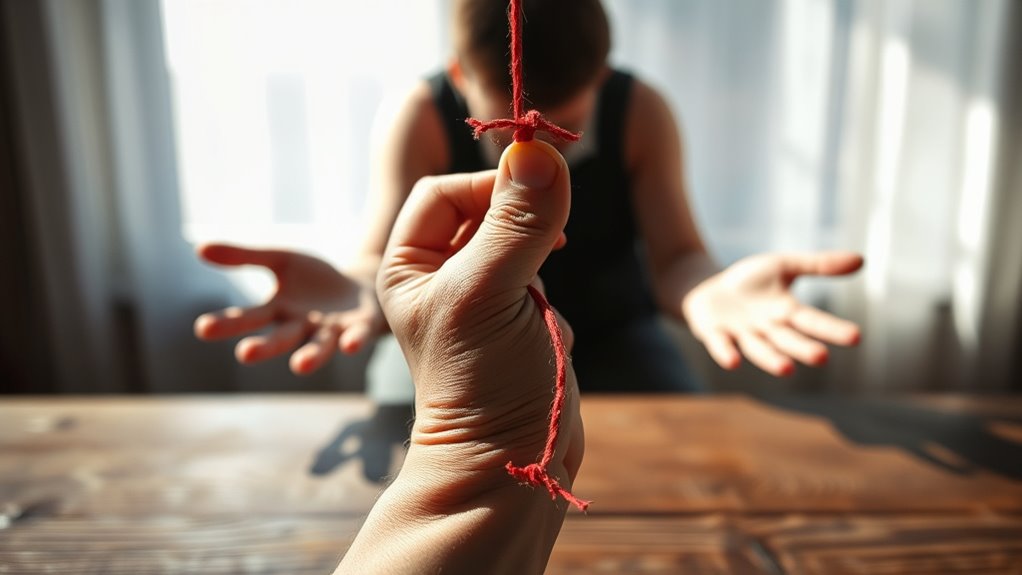To break free from the cycle of trauma bonding, start by recognizing manipulation patterns and understanding the deep emotional dependence you feel. Seek support from a therapist and build a safe network to help you heal. Set clear boundaries and limit contact with the abuser to regain control. Focus on self-care, rebuild your self-esteem, and develop long-term strategies for recovery. Continuing to explore these steps offers more guidance to help you move forward.
Key Takeaways
- Recognize manipulation tactics and underlying traits like Borderline Syndrome to understand the cycle.
- Establish and enforce firm boundaries to prevent emotional enmeshment and regain control.
- Seek trauma-informed therapy to process past abuse and develop healthy coping strategies.
- Build a support network to provide validation, accountability, and encouragement during recovery.
- Focus on self-care, resilience, and personal growth to break emotional dependence and foster independence.
Recognize the Signs and Understand the Dynamics

Recognizing the signs of trauma bonding is essential to breaking free from its hold. You might notice emotional dependence, feeling unable to leave because of a deep connection that keeps you attached.
You could find yourself rationalizing abusive behavior, convincing yourself it’s not so bad or that it’s for your own good. Enmeshment might blur your sense of identity, making you feel lost or confused about who you are.
Feeling powerless is another indicator—you may sense that you’re trapped and helpless. The cycle of intermittent reinforcement, where kindness is mixed with abuse, intensifies your emotional ties.
Abusers often manipulate and gaslight you, creating confusion and eroding your self-esteem. Recognizing these patterns helps you understand that your relationship is unhealthy and sets the stage for change.
Additionally, understanding digital literacy and critical thinking skills can empower you to recognize manipulation and misinformation, which are often used to sustain toxic dynamics. Developing these skills enables you to better identify narcissistic behaviors and resist emotional exploitation.
Gaining awareness of these warning signs can also help you differentiate between genuine affection and manipulative tactics, making it easier to break free from the cycle. Incorporating emotional intelligence can further enhance your ability to recognize and respond to unhealthy relationship patterns.
Furthermore, understanding the underlying Borderline Syndrom traits in both yourself and others can provide insight into the emotional volatility that sustains these cycles, helping you develop healthier boundaries.
Seek Professional Support and Build a Support System

Seeking professional support and building a strong support system are essential steps in healing from trauma bonding. Therapy options like cognitive-behavioral, dialectical behavior, and trauma-focused therapies can help you understand and break patterns of abuse. A safe, non-judgmental space allows you to explore your experiences and process trauma effectively. Incorporating evidence-based approaches can enhance your recovery process and help you develop healthier coping strategies. Additionally, understanding how vetted products for safety and effectiveness can contribute to your well-being may empower your healing journey. Therapists assist in identifying unhealthy behaviors, helping you reclaim autonomy and self-worth through evidence-based approaches tailored to your needs. Incorporating Louisiana alimony laws and understanding court considerations can also be beneficial if your trauma is related to an abusive divorce or custody situation. Alongside therapy, creating a support network—including friends, family, support groups, and online communities—provides emotional and practical assistance. Building a trustworthy support system fosters resilience and encourages ongoing healing. Sharing experiences with others who understand your journey reduces feelings of isolation and builds resilience. Developing healthy boundaries is crucial for maintaining your well-being and preventing future cycles of trauma. Access to these resources is crucial for healing, growth, and regaining control over your life.
Establish Boundaries and Limit Contact

To break free from trauma bonding, establishing clear boundaries and limiting contact with the abuser are essential steps. Recognize your emotional limits and communicate them assertively to maintain your autonomy. A well-defined personal space helps reinforce your emotional independence and prevents further manipulation. This might mean refusing to engage in draining conversations or reducing interactions altogether. Setting and consistently enforcing boundaries reinforces your self-respect and emotional well-being. Limiting the sharing of personal information protects you from emotional manipulation and prevents the abuser from exploiting vulnerabilities. Additionally, understanding the importance of dog names can serve as a positive focus during your recovery process, helping you regain a sense of normalcy and control. Recognizing soulmate angel numbers can also provide spiritual reassurance and motivation during healing. Developing emotional resilience is crucial for overcoming the cycle of trauma bonding and maintaining your progress. Creating a safe environment by removing yourself from triggering situations is vital for your mental health and recovery. Reducing contact—such as blocking communication channels and avoiding places where encounters might happen—helps create physical and emotional distance, allowing you to detach and focus on your healing. These measures prioritize your safety and help break the cycle, making space for recovery and growth.
Focus on Self-Care and Rebuild Self-Esteem

After setting boundaries and limiting contact, focusing on self-care and rebuilding your self-esteem become essential steps in healing from trauma bonding. Use stress reduction techniques like mindfulness, meditation, and deep breathing exercises to promote emotional balance. Engaging in activities such as journaling, creative arts, or physical exercise helps process emotions and boosts mood. Spend time in nature or read self-help literature for inspiration and clarity. Building a supportive network through friends, family, or therapy provides vital emotional support. Prioritize your physical well-being by maintaining a balanced diet and getting enough sleep. To rebuild confidence, practice positive affirmations, set achievable goals, and celebrate small successes. Focusing on mental well-being solutions like relaxation techniques can further enhance emotional resilience and aid recovery. Incorporating AI-driven insights can help identify patterns and support your healing journey. Implementing these strategies fosters resilience, restores self-worth, and lays the groundwork for lasting healing.
Develop Long-Term Strategies for Recovery

Developing long-term strategies for recovery is essential to maintaining your progress and building a healthier future. Seek trauma-informed therapy with professionals trained to help you process trauma and rebuild life skills. Find a therapeutic approach that fits your needs, and work with your therapist to create a safety plan that makes you feel secure during healing. Recognize the importance of emotional healing in overcoming the lasting effects of narcissistic abuse. Learning resilience techniques can help you better handle setbacks and emotional fallout, promoting sustained recovery. Incorporating trust-building exercises into your recovery plan can strengthen your confidence in relationships and reduce fears of betrayal. Learning about different healing modalities can provide additional tools and perspectives to support your journey. Utilize coping strategies to manage emotional fallout effectively, ensuring you stay grounded during challenging moments. Learn stress management techniques to handle emotional fallout, and focus on rebuilding life skills that promote independence. Establish a trusted support network by surrounding yourself with positive people, joining support groups, and engaging with online communities. Additionally, prioritize personal growth through self-discovery, goal setting, and exploring passions. Avoid re-engagement with abusers and learn about healthy relationship models to sustain your recovery journey.
Frequently Asked Questions
How Long Does It Typically Take to Break a Trauma Bond?
Breaking a trauma bond doesn’t have a set timeline because it varies for each person. Factors like the severity of the trauma, your resilience, and the support you receive influence how long it takes.
With consistent therapy, support, and self-care, you’ll gradually notice progress.
Remember, healing is a process, and patience is key.
Focus on your growth and celebrate small victories along the way.
Can Trauma Bonds Form in Non-Abusive Relationships?
Ever wonder if trauma bonds can form without abuse? In healthy, non-abusive relationships, they typically don’t. Trauma bonds rely on cycles of manipulation, control, and reinforcement—elements absent in respectful partnerships.
Instead, these relationships thrive on trust, open communication, and mutual respect. While strong emotional connections develop naturally, they don’t create the harmful dependency seen in trauma bonds.
Your focus should be on maintaining healthy boundaries and fostering genuine, supportive bonds.
Is It Possible to Recover Without Professional Therapy?
You can recover from trauma bonding without professional therapy by focusing on self-education and awareness. Recognize unhealthy patterns, build a support network of trusted friends and family, and engage in personal healing strategies like journaling, self-care, and hobbies.
Constructive conversations and documenting your progress reinforce your journey. While therapy helps, your commitment to understanding yourself and seeking support can substantially aid your recovery and break free from unhealthy attachments.
How Do Trauma Bonds Affect Children Differently?
Trauma bonds impact children differently by shaping how they see relationships and themselves. You might notice they struggle to trust others, become emotionally dependent, or excuse abusive behaviors.
Some children may reenact past trauma, exhibit loyalty to their abuser, or hide their feelings. These bonds can disrupt emotional growth, leading to confusion, anxiety, or difficulty forming healthy connections later in life.
Recognizing these effects helps you support their healing process.
Are There Warning Signs Before Entering a Trauma Bond?
Before entering a trauma bond, watch for warning signs like love bombing, where someone showers you with affection too quickly.
Notice manipulative behaviors such as guilt trips or gaslighting, and be cautious if they isolate you from friends or family.
If you see emotional highs and lows, or if you find yourself justifying their hurtful actions, trust your instincts.
Recognizing these signs early helps you avoid falling into a cycle of abuse.
Conclusion
Breaking free from trauma bonding requires awareness, action, and resilience. Recognize the signs, seek support, and set boundaries. Prioritize self-care, rebuild your confidence, and develop lasting strategies for recovery. Stay committed to your healing journey, embrace your strength, and nurture your well-being. Remember, breaking the cycle isn’t immediate, but with persistence, support, and self-love, you can reclaim your life and foster a healthier future. Your healing begins today—take that first step.











